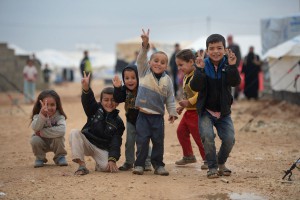By Tuğba Metinyurt, University of Massachusetts Lowell
Image credit: https://res.cloudinary.com/tremr/image/upload/dugn5ijc64amyiem3egp.jpg
“My adolescence, it was taken from me. I feel that I am in a different world, as if I am not living. Sometimes I wish we died before seeing what we saw. I wish we never came to this world and saw this.”
These words belong to a 16-year-old refugee girl, who fled violence in her home country (Kashi, 2014).
According to annual situation report by UNICEF, in November 2014, 10.9 million Syrians were displaced outside of Syria, including over 3.3 million refugees across Lebanon, Jordan, Iraq, Turkey and Egypt. More than half of the refugee population are children. (UNICEF, 2014a, p.1) Syria’s children have witnessed too many violent and traumatic acts. Consequently, they are growing up with feelings of mistrust, betrayal, anger, displacement and uncertainty about their future. Children under the age of 18 are growing up in unsanitary conditions, in need of education, and in need of healthcare and psychological support. These children are at risk of becoming a “lost generation” and they need a sense of belonging in their new environment as well as basic humanitarian needs.
The recently published Bahcesehir Study of Syrian Refugee Children in Turkey (Ozer, Sirin, Oppedal, 2015) interviewed refugee children from Syria. According to this study, three in every four Syrian children had lost a loved one due to the bloody conflict; one in every three children had been hit, tortured or shot at in the course of the conflict. In addition, many people lost access to healthcare and are living in unsanitary conditions where the risk of disease is high. 2,000 schools have either been damaged by the fighting or become temporary shelters for displaced people, greatly disrupting Syrian education. (p. 20-25)
Community psychologists provide services for refugees and seek solutions to provide mental health and health care services, to enhance protective factors such as social support, to engage children and adolescents in preventing discrimination, violence, abuse, exclusion, prejudice and separation of children through educational programs. They also attempt to address the social and physical causes of psychological distress in refugees.
Providing healthcare and education services is vital for protecting the host communities and the refugees. In doing this, they can prevent the built up anger that may threaten host communities in the near future. As Ozer and Sirin stated (2013), “…places like Afghanistan or Rwanda should remind us what happens when refugees are left to their own devices: camps, full of people who feel forgotten and, therefore, hopeless and angry, becomes recruitment grounds for child soldiers. This cycle carries the civil unrest across generations.” To avert this cycle, community psychologists can take an active role in creating a sense of belonging and helping refugees connect to their community. To achieve this goal, time banking can be used as a tool to develop links between refugees and host communities. Time banking is a reciprocity-based economic system where time, instead of money, serves as currency. Time banks allow communities to come together and trade services, connecting people, filling needs, and creating growth. “This program gives refugees and host communities the opportunity to earn time credits for voluntary work and to exchange these credits for the equivalent amount of time of someone else’s skills, serving to develop links between refugees and host communities.” (Webster & Robertson, 2007, p. 156).
It is also promising that many non-profit organizations from around the world, such as UNICEF, USAID, and Save The Children are working together to save Syria’s children. UNICEF is lending a helping hand to these children and their families, providing psycho-social support as well as shelters, warm clothes and accessible education for children (UNICEF, 2014b). In addition to UNICEF, the USAID- No Lost Generation project helps provide psycho-social services through women’s health centers, mobile clinics, and outreach workers to help Syrians deal with the stresses of conflict and displacement. It also leads parent support programs which focuses on helping mothers, fathers, and caretakers develop the skills to cope with stress and to provide protective care for their children (USAID, 2014). The Save The Children team is another organization that runs alternative learning programs and informal education in refugee camps and host communities, providing safe play areas and access to counseling for thousands of children across the region. They also launch back-to-school campaigns to encourage parents to enroll their children (Save The Children, 2014).
If you would like to learn more about the lives of Syrian refugees, I would recommend a short documentary called Syria’s Lost Generation, (Syria’s Lost Generation).
#commpsych
Tuğba Metinyurt is a graduate student in the Community Social Psychology program at the University of Massachusetts Lowell.
References
Kashi, E. (Director). 2014 Syria’s Lost Generation: Directors Give Voice to War’s Young Refugees. Podcast retrieved from:http://talkingeyesmedia.org/syrias-lost-generation
Ozer, S., &, Sirin, S., (2013, April 30). Provide Education and Health Care for the Refugee Children in Syria, The New York Times. Retrieved from:http://www.nytimes.com/roomfordebate/2013/04/29/finding-solutions-for-syrias-growing-refugee-crisis/provide-education-and-health-care-for-the-refugee-children-in-syria
Ozer, S., Sirin, S. & Oppedal, B. (2015). Bahcesehir Study of Syrian Refugee in Turkey. Retrieved from: http://www.fhi.no/dokumenter/4a7c5c4de3.pdf
Save The Children. (2015). Retrieved from:http://www.savethechildren.org/site/c.8rKLIXMGIpI4E/b.7998857/k.D075/Syria.htm
UNICEF. (2014a). Syria Crisis- 2014 Annual situation report, 1-5. Retrieved from: http://www.unicef.org/appeals/files/UNICEF_Syria__Annual_Regional_Crisis_Situation_Report_2014_.pdf
UNICEF. (2014b). Retrieved from: http://www.unicef.org/appeals/syrianrefugees.html
USAID. (2014). Retrieved from: https://www.usaid.gov/results-data/success-stories/coping-conflict-helping-syrians-overcome-trauma-war
Webster, A., Robertson, M., (2007). Can Community Psychology Meet the Needs of Refugees? The Psychologist, 20(3), 156-158. Retrieved from: http://thepsychologist.bps.org.uk/

